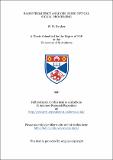Radiofrequency analysis using optical signal processing
Abstract
The basic form of conventional electronic and acoustooptic radiofrequency spectrum analysers is described. The advantages and disadvantages of the various systems are discussed with particular reference to radar signal processing in a hostile environment. Acoustooptic interaction is described using electromagnetic wave theory and also in terms of particle dynamics. A discussion of the various factors which effect Bragg-cell performance is presented, together with experimental results from the characterisation of acoustooptic cells. Coherent light detection is described when used in conjunction with a Bragg-cell spectrum analyser. Using this approach the dynamic range of the device may be dramatically increased. A novel approach is described which uses optical fibres in the Fourier transform plane and fusion spliced couplers to combine the signal and local oscillator beams. Experimental results are presented using single-mode fibres. Improvements in diffraction efficiency, reduced material intermodulation and increased frequency resolution are possible in an acoustooptic spectrum analyser if a Bragg-cell with a long transducer is used. However this leads to reduced instantaneous bandwidth in a conventional configuration. Two new approaches are described which allow a long transducer to be used without loss of bandwidth. An analysis of Bragg-cell diffraction within active and passive resonant optical cavities shows the diffraction efficiency per watt of a Bragg-cell may be increased by orders of magnitude by placing it within a passive cavity. Various cavity configurations are analysed and experimental results are given. A temporal analysis of light diffracted from radiofrequency pulses within an acoustooptic Bragg-cell is presented. Experimental evidence backs up the theory, which shows a possible means of eliminating the "Rabbit's Ears" phenomenon. Conventional acoustooptic Bragg cells have bandwidths limited by the acoustic losses in the crystals used for the cells and impedance matching of the transducer to the driver and crystal. Commercial cells are available with bandwidths of several gigahertz. Many applications require significantly larger bandwidths than are offered by conventional Bragg cells. We describe a new kind of diffraction cell with a potential bandwidth in excess of fifty gigahertz. The theory of operation and an example design are presented. A novel ultra-high data rate optical communication link is described. This makes use of the temporal distribution produced by light diffracted from radiofrequency pulses within a Bragg-cell. Also a covert, free-space link is described. A two channel system is demonstrated using acoustooptic cells.
Type
Thesis, PhD Doctor of Philosophy
Collections
Items in the St Andrews Research Repository are protected by copyright, with all rights reserved, unless otherwise indicated.

